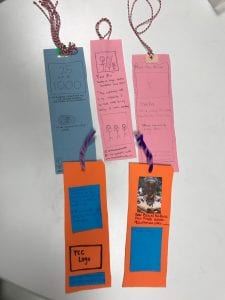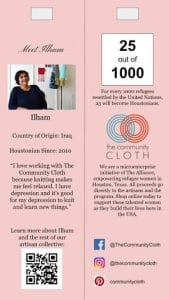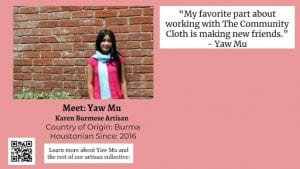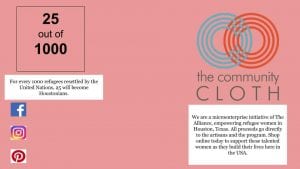This week, Team Thread Together drew from the insights we had gained during the previous weeks to build lo-fidelity prototypes of our design. One audience comment after our Mid-Semester Review presentation was that consumers would be more likely to hang onto our design if it were multipurpose. In our team meeting, we decided that in addition to prototyping postcard-style designs, we should also prototype bookmarks. We agreed that we personally tend to keep bookmarks that we acquire at various events because they are useful and unobtrusive.
We also discussed what content we thought we should include in our design. Our favorite comment from the audience response forms at Mid-Semester Review was, “Stats had me shook,” so we decided that a statistic about refugees in Houston could be an effective attention-grabber. We agreed that aesthetics were important, so we planned to incorporate photos and colors into our design. Other content selections included a QR code linking to The Community Cloth’s website, information about a specific artisan, and a statement about The Community Cloth itself.
At Saturday’s Open Studio, we rapidly created prototypes of our bookmark design. We use lo-fidelity prototypes at the beginning of the build/test process so that we can generate many iterations of various designs without using up expensive resources. It is also easier to be creative when one is less worried about messing up. Prototyping with construction paper, string, and markers makes the stakes of the process very low.
Our team prototyped several bookmark designs at Open Studio.
A close-up of one side of one of our bookmark designs shows TCC’s logo and mission statement and a QR code linking to its website.
The next team meeting was spent further prototyping the bookmark and postcard designs. We used Google Slides for easy editing. We observed that the bookmark would allow us to tell a story more easily because consumers would automatically read it from top to bottom, whereas the postcard looked somehow both crowded and sparse. Seeing the lo-fidelity prototypes allowed us to figure out which design category (bookmark or postcard) would be most attractive to consumers and best achieve our goal of bringing The Community Cloth’s story to socially conscious customers.
The bookmark design concisely compiles the content in an effective format.
The postcard design contains the same information but is not nearly as nice aesthetically.




